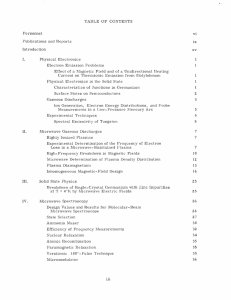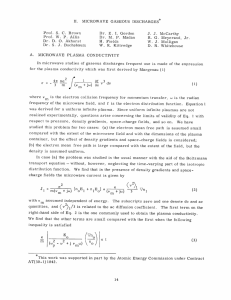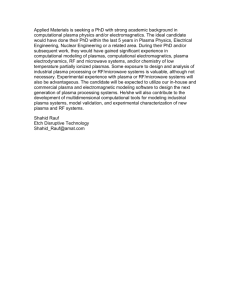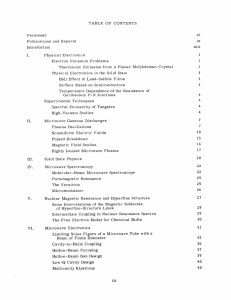II. MICROWAVE GASEOUS DISCHARGES W. R. Kittredge
advertisement
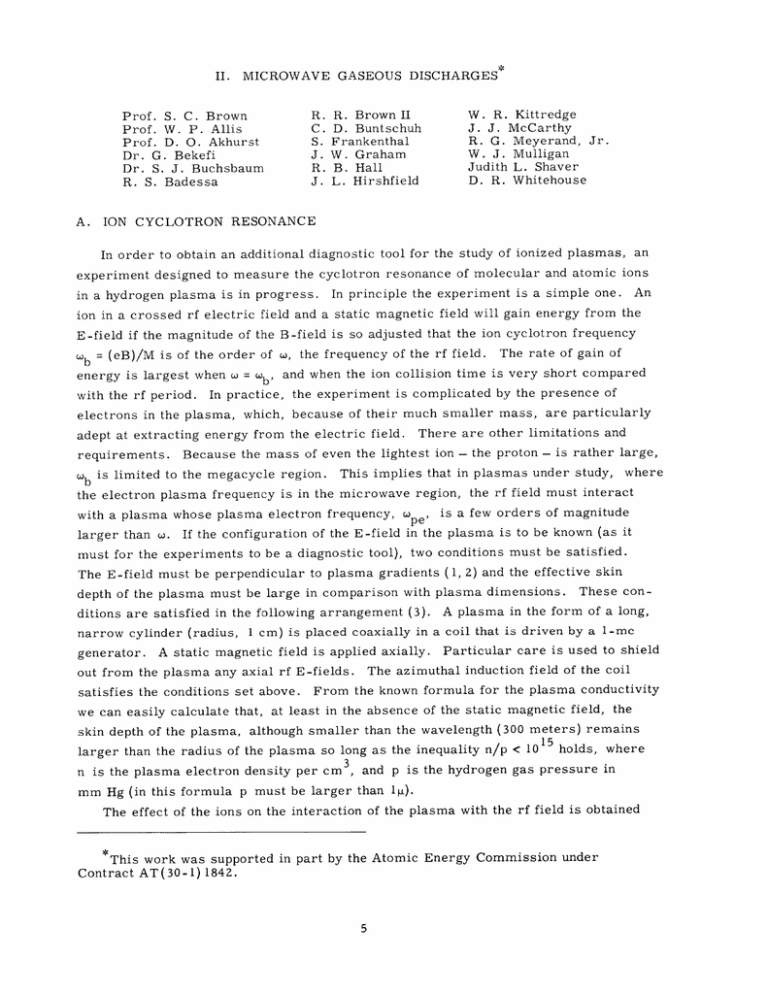
II.
MICROWAVE GASEOUS DISCHARGES
R.
C.
S.
J.
R.
J.
Prof. S. C. Brown
Prof. W. P. Allis
Prof. D. O. Akhurst
Dr. G. Bekefi
Dr. S. J. Buchsbaum
R. S. Badessa
A.
R. Brown II
D. Buntschuh
Frankenthal
W. Graham
B. Hall
L. Hirshfield
W. R. Kittredge
J. J. McCarthy
R. G. Meyerand, Jr.
W. J. Mulligan
Judith L. Shaver
D. R. Whitehouse
ION CYCLOTRON RESONANCE
an
In order to obtain an additional diagnostic tool for the study of ionized plasmas,
experiment designed to measure the cyclotron resonance of molecular and atomic ions
in a hydrogen plasma is in progress. In principle the experiment is a simple one. An
ion in a crossed rf electric field and a static magnetic field will gain energy from the
E-field if the magnitude of the B-field is so adjusted that the ion cyclotron frequency
Ob = (eB)/M is of the order of o, the frequency of the rf field. The rate of gain of
energy is largest when w = b,
with the rf period.
and when the ion collision time is very short compared
In practice, the experiment is complicated by the presence of
electrons in the plasma, which, because of their much smaller mass, are particularly
There are other limitations and
adept at extracting energy from the electric field.
requirements.
Because the mass of even the lightest ion - the proton - is rather large,
Ob is limited to the megacycle region.
This implies that in plasmas under study,
where
the electron plasma frequency is in the microwave region, the rf field must interact
with a plasma whose plasma electron frequency,
larger than o.
pe,
is a few orders of magnitude
If the configuration of the E-field in the plasma is to be known (as it
must for the experiments to be a diagnostic tool),
two conditions must be satisfied.
The E-field must be perpendicular to plasma gradients (1, 2) and the effective skin
These condepth of the plasma must be large in comparison with plasma dimensions.
ditions are satisfied in the following arrangement (3).
narrow cylinder (radius,
generator.
A plasma in the form of a long,
1 cm) is placed coaxially in a coil that is driven by a 1-me
A static magnetic field is applied axially.
out from the plasma any axial rf E-fields.
satisfies the conditions set above.
Particular care is used to shield
The azimuthal induction field of the coil
From the known formula for the plasma conductivity
we can easily calculate that, at least in the absence of the static magnetic field, the
skin depth of the plasma, although smaller than the wavelength (300 meters) remains
15
holds, where
larger than the radius of the plasma so long as the inequality n/p < 10
3
n is the plasma electron density per cm , and p is the hydrogen gas pressure in
mm Hg (in this formula p must be larger than 14).
The effect of the ions on the interaction of the plasma with the rf field is obtained
*This work was supported in part by the Atomic Energy Commission
under
Contract AT(30-1) 1842.
(II.
MICROWAVE GASEOUS DISCHARGES)
from the plasma conductivity tensor,,
obtained by Allis (4).
The o
component of T
(the diagonal component), is given by
ne
2
1
=2
002m
1
+ Vm e
me +j(w+bee
m
o
b
1
m
+M
+ i-be
m
v m i +J (+b)
b
1
+ V m.
+J(W-Wb
m.
+O-ee
(1)
1
e
where, for simplicity, we assumed only a single ion specie of mass M and where the
subscript e refers to electrons and subscript i to ions. In the absence of the static
magnetic field, the effect of the ions is negligible as a consequence of the smallness of
the mass ratio m/M. At ion cyclotron resonance, however, (c = ob. i , the contribution
of ions to o-6
can be made appreciable.
2
0- 6.
Re %o
R-
Re
0
00
i
For example, the ratio
b
e
m
~ Mv
e
m.
v
m
e
which measures the relative energy loss to ions and electrons, can easily be made
unity or larger by reducing the collision frequencies vm and v
.
In an active hydro1
gen plasma, vm
6 X 10
e
e
p, where p is the pressure in mm Hg; vm. for atomic ions
1
is not well known (it is one of the objects of this experiment to measure the elastic collision cross-section of thermal protons), but vm. for molecular hydrogen ions can be
1
calculated from the known ambipolar diffusion coefficient to be approximately 2 X 10
for thermal ions. We must have v
< w for the resonance effect to be measurable.
m.
p
1
This sets the upper limit on the pressure as approximately 0. 1 mm Hg. At this pres5
sure the ratio -M
R is approximately 10 , and is more than sufficient to offset the smallness of the mass ratio m/M. The current given by r0 0 is not the only current that will
flow in the plasma.
Other components of the tensor will also contribute. Calculations
are now in progress to determine the total effect of ions and electrons on the reflected
impedance of the coil by taking into account all elements of the tensor and proper
boundary conditions.
The disadvantage of the experimental arrangement is known to be the rather small
effect that the plasma will have on the effective inductance and resistance of the coil.
For example, in the absence of the static magnetic field, for an infinite coil of radius
a and a plasma of uniform electron density n and radius R, the change in the Q value
of the coil is given by
MICROWAVE GASEOUS DISCHARGES)
(II.
average power dissipated
-
energy stored
2
2
P
W -r
2 W2 Vm
e
-18
n
p
where n is the density per cm
assumed that v
> w.
3,
For a plasma density of 10
e
7
in the Q is only 1 part in 10
m
-
and p is the pressure in mm Hg and where it was
10
3
cm-
and p = 0. 1 mm,
the change
The change in inductance is smaller still, being given
. A twin-T circuit capable of detecting these small impedance changes
is discussed in Section II-B.
S. J. Buchsbaum
References
Phys.
Rev.
106, 196 (1957).
1.
S. J. Buchsbaum and S. C. Brown,
2.
K-B. Persson, Phys.
3.
4.
K-B. Persson, private communication.
W. P. Allis, Handbuch der Physik, Vol. XXI, p. 413.
B.
ION CYCLOTRON RESONANCE MEASUREMENT SYSTEM
Rev.
106,
191 (1957).
Measurement of ionized plasma properties in the ion cyclotron resonance experiment requires measurement of aL/L, the normalized change in measurement coil
inductance, and (aR)/(AL), the normalized change in resistance. A system using a
twin-T null network (1) with substitution that is synchronous with periodic modulation
of aL and aR has been developed.
The measurement solenoid and modulator coil is shown in Fig. II-1. The 1-mc
coil (top) is shown with one end of its electrostatic shield removed to expose the interior winding. The radial vanes and shielded cable connections to the coil winding are
The radial vanes assist the electrostatic shield in removing the axial electric
The plasma discharge tube fits inside the vanes. The lower portion of the photo
evident.
field.
shows the modulator coil that surrounds the 1-mc measurement coil. The function of
the modulator coil is to vary (at 100 cps) the axial magnetic flux density B and, therefore, to modulate periodically the ion cyclotron frequency. It is by this modulation
process that 8R and aL are varied.
They are reflected as very small periodic varia-
tions in the input impedance of the measurement coil.
(II.
MICROWAVE GASEOUS DISCHARGES)
Fig. II-1.
Measurement coil (top) and modulator coil (bottom).
A simplified block diagram of the complete measurement system is shown in
Fig. 11-2.
The physical arrangement of various coils that are associated with the
experiment is indicated at the top of the figure.
is adjusted so that its null is at 1 mc.
Stated briefly, the twin-T null network
Periodic modulation at 100 cps in the plasma
generates sidebands at the detector output.
Three amplification and mixing operations
are performed to recover the upper sideband and to measure its components in terms
of conductance and susceptance.
the diagram.
Some details of the detection process are shown in
Substitution measurements are accomplished by modulating the main
balance capacitances in the twin-T so that a sideband equal in amplitude and opposite
in phase to the signal is generated.
put is zero.
With the proper substitutions, each integrator out-
An accurate estimate of the measurement coil impedance change at 100 cps
is then obtainable from a knowledge of the substitution modulator characteristics.
The
accuracy of the measurement is not dependent upon the detector gain or phase characteristic.
A photograph of the complete electronics of the system is shown in Fig. 11-3.
The
left portion of the equipment consists basically of the 1-mc generator and power amplifier,
I
twin-T null circuit, and 100-cps substitution generator.
I
The twin-T is the unit
DC SUPPLY
CONDUCTANCE
SUBSTITUTION
BALANCE
INDICATOR
Fig. II-2.
SUSCEPTANCE
SUBSTITUTION
BALANCE
INDICATOR
Ion cyclotron resonance measurement system.
Fig. 11-3.
Ion cyclotron resonance measurement system.
10
MICROWAVE GASEOUS DISCHARGES)
(II.
The subwith the two large main balance controls visible just below the oscilloscope.
The
stitution modulator controls are located at either side of the balance controls.
right side of the unit is devoted mainly to the detector units, power modulator unit, and
their associated power supplies.
First measurements of detectability and measurement accuracy indicate that the
residual noise level in normalized rms parts (with 3.5 seconds integration time) is
about 10 -
9
Normalized rms inductance change is about the same
in coil resistance.
level.
Reasonably accurate estimates of relative loss and inductance changes require
reasonable signal-to-noise ratios. Therefore, a normalized impedance change of about
--88
10 -
represents the lower bound for accurate measurements.
J. W.
Graham, R. S. Badessa
References
1.
C.
W. N. Tuttle, Bridge-T and parallel-T null circuits for measurements at radio
frequencies, Proc. IRE 28, 23-29 (Jan. 1940).
MEASUREMENTS OF THE COLLISION CROSS SECTION AND OF THE
ENERGY LOSS OF SLOW ELECTRONS IN HYDROGEN
The work outlined in the Quarterly Progress Report of January 15,
has been completed; the final results are shown in Fig. 11-4.
1958,
page 14,
G. Bekefi
lox 2m
M
60
oU)
0
-J
6
50
(D
z z0o
4J
40
-j
z
0
23
30
I0
0
I
0.2
,I
I
0.4
I
II
06
0.8
I
ELECTRON
Fig. 11-4.
I
1.0I
I
I
1.2
I
I
I
I
0
o0
cr
w~
0
VELOCITY ( VOLTS )1/2
Collision probability and energy loss of slow electrons in hydrogen as a
function of the electron velocity (m is the mass of the electron; M is the
mass of the hydrogen molecule).
(II.
D.
MICROWAVE GASEOUS DISCHARGES)
MICROWAVE
MEASUREMENTS OF ELECTRON TEMPERATURES
IN THE PRESENCE OF A STATIC MAGNETIC
FIELD
It is well known that electrons (and ions) in a crossed microwave E-field and a static
B-field exhibit a cyclotron resonance
the cyclotron frequency
when the microwave frequency W is
equal to
ab[= (eB)/m]. It will be shown that a resonance also occurs
when the microwave E-field is parallel to the B-field if the plasma temperature is
finite (so that the Larmor radius of the average electron is not zero) and if the plasma
finds itself in a region where there exists an appreciable gradient of the E-field in a
direction perpendicular to the B-field.
In a properly designed experiment,
the magni-
tude of the resonance is directly proportional to the square of the Larmor radius and
hence it can be used as a direct determination of the electron (or ion) temperature.
Simple Analysis
The motion of an average electron in parallel E- and B-fields along the direction of
the fields (assumed to be along the z-axis) is given by
dv
m -
m
+ mv
v
m z
= e[E r(t)] et
(1)
where we assumed that the microwave field is axially symmetric and that it is a function
of the radius; vm is the collision frequency for momentum transfer (assumed to be independent of electron velocity).
E (r)E(r+
Expanding E about ro, the position of the guiding center,
dE (r- r
+ ...
dr
(2)
and setting
r - ro Z rb cos(wbt +
where r
b
4)
(3)
is the Larmor radius and wb is the cyclotron frequency,
the solution to Eq.
is obtained:
eLE(ro)
rb dE
jv +
+
dr
m
o
exp [j (abt + )]
V
+ vm
m +
j+(+exp
b
exp [-j (wbt+)]
vm + j
b)
)
(jt
+
v
)
(4)
m
In microwave diagnostics we are interested in the time average of J*. E/2; Re J*. E/2
is the microwave power per unit volume dissipated in the plasma and is, therefore,
related to the change in the loaded Q value of the cavity while Im J • E/2 is the average energy density stored in the plasma and, therefore,
resonant frequency of the cavity.
is related to the shift in the
Since J = nev, where n is
neglect the contribution of the ions), we have
electron density (we
1
(II.
m
= ne2
J
ecn2
m
rb dE
dr
o
+2
+v
M
MICROWAVE GASEOUS DISCHARGES)
m
(
V2 + (-2
v
+
V2 + (
b
+b
by
wb
(5)
2
b)
The change in the Q value of the cavity is then given by
2
r
+
(') U2
b
2n(
v
Vm A)
p [(dE)/(dr)] 2 dv
/
m 2 +[l(W-Wb)/w]' 2
2
/W)
c
E
2
dv
(6)
where subscripts p and c indicate integrations over the volume of the plasma and cavity, and where, for simplicity,
resonant term.
we assumed a uniform plasma and neglected the non-
The first term of Eq. 6 is the one commonly used in microwave
The second term exhibits a resonance at
diagnostics in the absence of a B-field.
W=
ob.
Its magnitude is proportional to r b and therefore to plasma temperature.
The
change in the resonant frequency of the cavity is given by
f
2
Af
1
f
2
p
EE2 dv
d
2
W
b)/w]
E 2 dv
m
2 +[(
[(dE)/(dr)] 2 dv]
P(7)
rb
E 2 dv
2
b)/]
I
c
c
Since in most plasmas the Larmor radius is very small [rb z 0.02 cm for T = 100 ev,
10
-l
see ] we must examine whether or not it is possible to observe the
=2 x 10
b
Consider the ratios
resonance effect experimentally.
A (1/Q)
b
2
+ (m/
2
m(Vm/)
(/Q) b
R
2
rb
for
m
m
co
<< 1 (8)
2
and
(Af/f)__
=
= rb
2
-
(Af/f) b 0
Ob
p
[(dE)/(dr)] 2 dv
2
2
1 + (vm/)2
Vm/W
a (b
-
2
v( )
mI
for -- )
<1
(9)
where
a
(10)
p E2 dv
We see that at low pressures (vm << w),
A(1/Q) is
the more sensitive of the two effects.
(II.
MICROWAVE GASEOUS DISCHARGES)
E(r)ejct
t C~~---O.a
Fig. 11-5.
To make R
is,
B
0 a
K---C
A TM010 cavity for microwave measurement of plasma temperature.
as large as possible, it is necessary to make a as large as possible; that
the plasma must be placed only in that part of the field where the gradient is large
1
but the field is small.
A possible field configuration is that of the TM 0 1 0 mode of a coaxial cavity whose
center conductor is thin. It was calculated that if the radius of the inner conductor is
one-tenth the radius of the outer conductor (see Fig. II-5) and if the plasma is allowed
to surround the inner conductor to a radius that does not exceed two-tenths of the radius
of the outer conductor, then in the plasma region the E-field varies approximately
linearly with the radius, and
R
r dr
1
R1
r
dr
2
It is then only necessary to make w/v
(11)
of the order of (R/rb) for the resonance to be
easily measurable.
A more stringent condition is the necessity of an exact alignment of the E- and
(II.
B-fields.
MICROWAVE GASEOUS DISCHARGES)
If there is a small angle 0 between them,
a "true" cyclotron resonance effect
resulting from the component of E at right angles to B may mask the resonance
The change in the Q value will then be
described above.
E 2 dv
2
p
Vm/W
+ O2
E
dv
2 +
E 2 dv
(m)
b
c E2 dv
C
(bN\
2
[(dE)/(dv)]
Vm/
+
(12)
[(-Wb)/w ]
(Vm/)2+
dv
E
2
dv
And we must have
< I(rb
(13)
for the temperature measurement to be accurate.
A More Rigorous Analysis
The simple analysis given above is in terms of the motion of an average electron and
is restricted to constant collision frequencies.
A rigorously correct description is
obtained from Boltzmann's equation
afaf
a+
v - Vf +-
atm
(E + v X B)
V f -
f
(14)
afcoll
c 01
Expanding the distribution function f and the fields in the standard manner (1)
E= E
f= fo + fl
o01
we obtain,
0
+E 1'
1,
B=B
+B
(15)
1
following Rosenbluth (2),
t
f1
1
exp(vmt) (E
me exp(-v t)
m
m
1
+ vX B 1 )
(16)
Vvfo dt
0
where the perturbed distribution function fl is caused by the fields E 1 and B
the integral follows the particle orbit in the six-dimensional phase space.
we have
B
1
=0
E
1
= E[r(t)] ejwt
= E(ro) +d
dE
0
j
rb cos (Wbt)} e wt
1
and where
In our case
(II.
MICROWAVE GASEOUS DISCHARGES)
Equation 16 is easily integrated:
e
E (ro)
m
vm +
rb dE
j
2
The microwave current J
e
J 1
dro
ex p (jobt)
m + jw
b)
exp (-jwbt)
+
m (w -
b)
v
o
(17)
is obtained from
f1
(18)
dv
0
To integrate Eq. 18 the unperturbed distribution function fo must, in general, be known.
If vm is independent of v, Eq. 18 reduces to Eq. 4.
S. J. Buchsbaum
References
1. W.
P. Allis, Handbuch der Physik XXI, p. 404.
2.
M. Rosenbluth, IInd Magnetohydrodynamic Symposium, Stanford,
E.
OPTICAL DIAGNOSTICS
1957.
An optical method has been devised for measuring the relative change of electron
energy or temperature of a changing plasma. The "effective" temperature, T, is so
defined that the tail of the actual electron distribution in the neighborhood of the excitation energies matches the tail of a theoretical Maxwellian distribution of temperature T.
In a low-pressure hydrogen discharge, the intensity of a line in the atomic spectra
is given by
Ip oc n nlX (T)
where ne and n1 are the electron and atomic specie densities, and Xp(T) is the unit
excitation frequency of the principal quantum level of the atom which leads to the monochromatic radiation of the line in question. For electron energies less than 5 volts, the
logarithm of the ratio of two line intensities,
such as the a and P lines of the Balmer
series, can be approximated by
I
In
where V
-
IP
(V
- V ) -1+C
aT
and Va are the threshold excitation energies of the respective atomic levels,
and C is determined by instrumental and physical constants. Thus the ratio of two line
intensities is independent of electron and atomic hydrogen densities.
(II.
MICROWAVE GASEOUS
DISCHARGES)
In practice, the constant C is difficult to evaluate, and only relative changes in
temperature can be measured as the line intensities vary.
1
Ina
Ini
1
(V-
Thus
n
p
n
i
This technique has been used to measure temperature changes in a pulsed microwave
discharge superposed on a steady-state microwave discharge. The electron density
and the ratio of density in the pulse to the density in
was measured with microwaves,
The time variation of the p and y line intensities were
the steady state was set at 10.
The results of the calculated change in I/T are plotted in
photographed and analyzed.
Fig. 11-6.
The plot of 1/T clearly shows that the electron energy decreases for high electron
densities, and increases for low electron densities. The decrease in energy can easily
account for the extinction of the plasma at high densities which is an observed fact.
The total change in reciprocal temperature is 0.2. Although the absolute temperature has not been measured,
1
T
1
T
it is clear from the expression
0.2
that T cannot be greater than 1/0.2 = 5 volts, regardless of the value of T o . T is
more likely to be in the neighborhood of 2 or 3 volts.
This evaluation,
therefore,
Figure II-6 also indicates that the temperature
an upper limit on the value of T.
puts
T
varies over a period of many milliseconds even though the electron density changes
1
I
I
_j 22
1
1
1
020.18
LU
0.16
a 014
0
0012
0.1 -
S008
-
I/
MICROWAVE PULSE
LOW- DENSITY
DISCHARGE
S0.04
o
ELECTRONS 0
ELECTRONS
n,=
2 I
0
I
2
3
4
CM
nei 2 x 1
M3
5
6
7
8
9
10
II
12
13
14
TIME (M SEC)
Fig. 11-6.
Pulsed microwave discharge (hydrogen gas,
po = 0. 934).
(II.
MICROWAVE GASEOUS DISCHARGES)
almost instantaneously.
This fact is the result of the build-up of atomic hydrogen den-
sity, and possibly water vapor, which provide a sink of energy for the electrons and
decrease their energy.
D. R. Whitehouse
